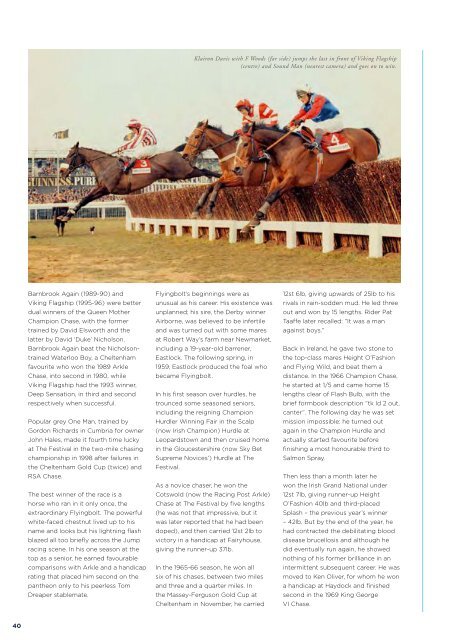THE FESTIVAL 2017 MEDIA GUIDE
CMG_2017_150217_digital
CMG_2017_150217_digital
Create successful ePaper yourself
Turn your PDF publications into a flip-book with our unique Google optimized e-Paper software.
Klairon Davis with F Woods (far side) jumps the last in front of Viking Flagship<br />
(centre) and Sound Man (nearest camera) and goes on to win.<br />
Barnbrook Again (1989-90) and<br />
Viking Flagship (1995-96) were better<br />
dual winners of the Queen Mother<br />
Champion Chase, with the former<br />
trained by David Elsworth and the<br />
latter by David ‘Duke’ Nicholson.<br />
Barnbrook Again beat the Nicholsontrained<br />
Waterloo Boy, a Cheltenham<br />
favourite who won the 1989 Arkle<br />
Chase, into second in 1980, while<br />
Viking Flagship had the 1993 winner,<br />
Deep Sensation, in third and second<br />
respectively when successful.<br />
Popular grey One Man, trained by<br />
Gordon Richards in Cumbria for owner<br />
John Hales, made it fourth time lucky<br />
at The Festival in the two-mile chasing<br />
championship in 1998 after failures in<br />
the Cheltenham Gold Cup (twice) and<br />
RSA Chase.<br />
The best winner of the race is a<br />
horse who ran in it only once, the<br />
extraordinary Flyingbolt. The powerful<br />
white-faced chestnut lived up to his<br />
name and looks but his lightning flash<br />
blazed all too briefly across the Jump<br />
racing scene. In his one season at the<br />
top as a senior, he earned favourable<br />
comparisons with Arkle and a handicap<br />
rating that placed him second on the<br />
pantheon only to his peerless Tom<br />
Dreaper stablemate.<br />
Flyingbolt’s beginnings were as<br />
unusual as his career. His existence was<br />
unplanned; his sire, the Derby winner<br />
Airborne, was believed to be infertile<br />
and was turned out with some mares<br />
at Robert Way’s farm near Newmarket,<br />
including a 19-year-old barrener,<br />
Eastlock. The following spring, in<br />
1959, Eastlock produced the foal who<br />
became Flyingbolt.<br />
In his first season over hurdles, he<br />
trounced some seasoned seniors,<br />
including the reigning Champion<br />
Hurdler Winning Fair in the Scalp<br />
(now Irish Champion) Hurdle at<br />
Leopardstown and then cruised home<br />
in the Gloucestershire (now Sky Bet<br />
Supreme Novices’) Hurdle at The<br />
Festival.<br />
As a novice chaser, he won the<br />
Cotswold (now the Racing Post Arkle)<br />
Chase at The Festival by five lengths<br />
(he was not that impressive, but it<br />
was later reported that he had been<br />
doped), and then carried 12st 2lb to<br />
victory in a handicap at Fairyhouse,<br />
giving the runner-up 37lb.<br />
In the 1965-66 season, he won all<br />
six of his chases, between two miles<br />
and three and a quarter miles. In<br />
the Massey-Ferguson Gold Cup at<br />
Cheltenham in November, he carried<br />
12st 6lb, giving upwards of 25lb to his<br />
rivals in rain-sodden mud. He led three<br />
out and won by 15 lengths. Rider Pat<br />
Taaffe later recalled: “It was a man<br />
against boys.”<br />
Back in Ireland, he gave two stone to<br />
the top-class mares Height O’Fashion<br />
and Flying Wild, and beat them a<br />
distance. In the 1966 Champion Chase,<br />
he started at 1/5 and came home 15<br />
lengths clear of Flash Bulb, with the<br />
brief formbook description “tk ld 2 out,<br />
canter”. The following day he was set<br />
mission impossible: he turned out<br />
again in the Champion Hurdle and<br />
actually started favourite before<br />
finishing a most honourable third to<br />
Salmon Spray.<br />
Then less than a month later he<br />
won the Irish Grand National under<br />
12st 7lb, giving runner-up Height<br />
O’Fashion 40lb and third-placed<br />
Splash – the previous year’s winner<br />
– 42lb. But by the end of the year, he<br />
had contracted the debilitating blood<br />
disease brucellosis and although he<br />
did eventually run again, he showed<br />
nothing of his former brilliance in an<br />
intermittent subsequent career. He was<br />
moved to Ken Oliver, for whom he won<br />
a handicap at Haydock and finished<br />
second in the 1969 King George<br />
VI Chase.<br />
40



